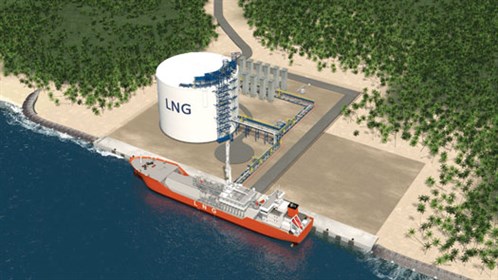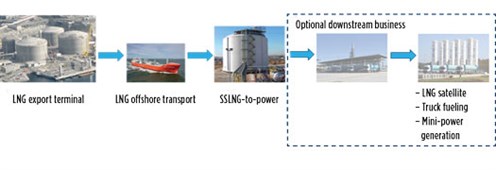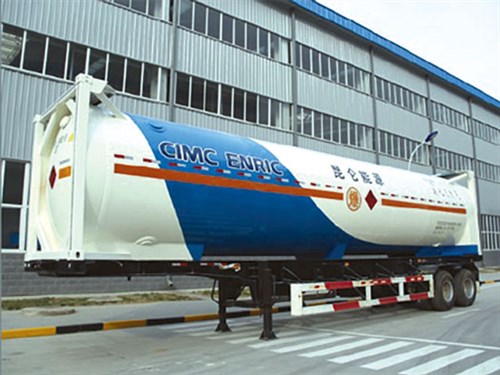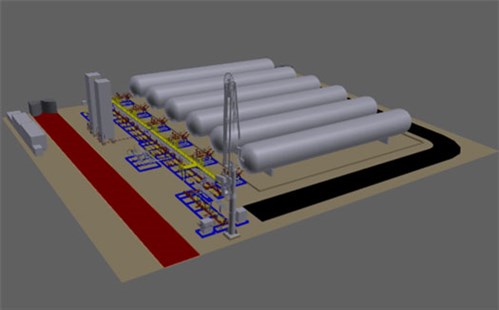SSLNG-to-power solutions for optimized CAPEX and OPEX
LNG-to-power has become an established term in the international energy industry, whereby gas-fueled power stations are exclusively supplied from an adjacent LNG storage terminal. Typically used for remote locations with no nearby natural gas pipeline grid in the vicinity, small-scale LNG (SSLNG)-to-power is the fuel supply solution.
On demand, these terminals can be additionally equipped with LNG distribution facilities—e.g., truck or ISO container loading. The market demand development of this type of infrastructure has been observed for several years already.
SSLNG-to-power business case. Multiple key drivers exist for the development of SSLNG-to-power projects. Lower LNG costs compared to oil will always be viewed positively. Additionally, increased LNG supply is coming from the expansion of existing, large-scale production facilities and the development of new facilities, particularly in the U.S. (using shale gas feed) and Russia (using arctic-region gas). High LNG supply can be expected for the upcoming decade to ensure stability of supply. A general increase in renewable energy sources also will be seen, particularly wind and solar; however, the renewable sources may not provide sufficient electricity on demand for high energy peaks.
The worldwide target for reduction of CO2 emissions will force the replacement of heavy-carbon fuels with lower-carbon methane fuel. Environmental and associated societal pressures will demand that governments push for greener developments, and may create further opportunity via reduced taxes, fees and funding.
Many market players understand SSLNG to mean LNG receiving installations with a yearly throughput up to 0.5 MMtpy. This is in comparison to “LNG as fuel” installations with throughputs below 0.05 MMtpy and, on the larger side, mid-scale LNG receiving terminals up to 2 MMtpy and world-scale LNG receiving terminals with throughputs greater than 2 MMtpy.
Many prospects exist in the global market whereby SSLNG-to-power installations will be viable economic and environmental solutions.
SSLNG-to-power supply chain. The typical LNG supply chain for an SSLNG plant is similar to that of other LNG supply chains. The LNG is received from an LNG liquefaction plant using an LNG carrier (LNGC) (FIG. 1); however, growth is seen in breakbulk LNG reception terminals, whereby larger deliveries are reloaded onto smaller LNGCs or barges for delivery to small-scale storage units. At the small-scale storage unit, the LNG can be stored, pumped and vaporized and then routed directly to a local power plant.
 |
| FIG. 1. The typical LNG supply chain for an SSLNG plant is similar to that of other LNG supply chains, whereby the LNG is received from an LNG liquefaction plant using an LNG carrier. |
In addition to supplying fuel directly to the power station, LNG can be supplied to other customers depending on the location. This may include LNG distribution to other LNG satellite stations, to LNG fueling stations, other mini-power generation sites or for fueling marine operations (FIG. 2).
 |
| FIG. 2. In addition to supplying fuel directly to a power station, LNG can be supplied to other customers, such as other LNG satellite stations, LNG fueling stations, other mini-power generation sites or marine operations. |
SSLNG-to-power plant outline. When establishing small-scale, standalone solutions, the first key features that must be assessed and designed are ship unloading and the requirements for additional marine infrastructure. Consideration must be given to the design of the LNG storage and regasification methods, as well as the boil-off gas management.
Additional options and synergies may be investigated. These include the “total solution” concept, whereby the power plant and LNG storage facilities are heavily integrated or have combined infrastructure. Further options may include additional truck loading for mini-scale power distribution, local industrial consumers and vehicle refueling stations.
The high-level concept for SSLNG-to-power remains virtually the same for varying power generation levels required; however, when optimizing the concept for a particular site or project, all applicable parameters must be considered.
Case studies for SSLNG-to-power. A number of case studies have been developed for varying levels of power generation of 25 MW, 100 MW and 150 MW. Power generation is based on simple-cycle engines with a thermal efficiency of 48%, using a typical LNG heating value, with one LNG cargo delivery every 4 wk and a delivery power of 8,000 hr/yr. TABLE 1 compares examples for the small-scale pressurized and atmospheric solutions.
 |
The delivery times of these project vary depending on several factors, including delivery times for the power units. However, when the project requires larger-size storage tanks, then the tank construction dominates the critical path.
The storage capacity is based on a 4-wk delivery term, but this will be subject to the availability of LNG in the specific market and the size of the LNG carrier available. Additional small LNGCs are coming into operation as the demand for smaller cargoes increases, which will provide a benefit to small-scale terminals. Another option may be to receive a portion of a cargo from a larger LNGC.
Modular design concept. Depending on the individual project, the construction concept can be optimized based on location and the type of equipment to be installed. Given the nature of the overall SSLNG-to-power concept, it can be assumed that the location is more than likely to be remote, with potentially low levels of infrastructure and construction labor availability.
The remote location will benefit from a minimum of in-situ construction and from equipment and plant sections being provided as modularized units. At least partial adherence to these targets will reduce construction costs by maximizing prefabrication. The modularized design approach brings clear advantages in plant expandability while fast-tracking project delivery time to enable the commencement of commercial operations and an optimized return on investment.
Mini-scale power production. At < 50 MW, these small-sized power plants usually serve the power demand of a smaller island without significant industrial power demand. The LNG can be transported via ISO containers on LNG trucks (FIG. 3) or by rail (often referred to as a “virtual pipeline”), with each holding approximately 43 m3 of product. They can be lifted from the trailer assembly or left in-situ on the trailer for distribution in the plant.
 |
| FIG. 3. ISO container on trailer used to store LNG at mini-scale power facilities. |
Although the storage is modular, these ISO containers provide an option for storage solutions up to 500 m3 and produce low levels of power generation. A significant advantage of using ISO containers is that the facility does not need to be in a marine location, but can be situated inland at more convenient sites. At the power plant, the LNG is stored in small, pressurized vessels.
Small-scale power production. As power generation requirements increase up to 50 MW, so does the size of the storage. The storage concept changes to utilize vacuum-insulated bullets, each with a typical capacity of 1,000 m3 (FIG. 4). Economic designs up to 10,000 m3 can be achieved, with the remainder of the plant being fully modularized, which means that the overall schedule can be reduced to approximately 16 mos–18 mos.
 |
| FIG. 4. As power generation requirements increase up to 50 MW, the storage concept changes to utilize vacuum-insulated bullets with a typical capacity of 1,000 m3. |
This concept does not incorporate a boil-off gas handling system; instead, the LNG is allowed to warm up within the storage, as the system can operate with zero sendout for up to 2 mos without any venting requirements
Star-fin ambient air vaporizers are a simple vaporization solution in this concept. They are a suitable technology for most climates; however, some additional heating may be required for colder climates.
Medium/large-scale power production. As power generation requirements increase to 50 MW–300 MW, the quantity of LNG required increases accordingly, and the storage requirement becomes greater than 10,000 m3. The economics for the storage concept change, and the optimum solution becomes an atmospheric-type storage.
These flat-bottomed tanks must be built in-situ and are built according to the relevant EN 14620 or API 620/API 625 codes. The containment type of the tank can be defined as single, double or full. For LNG storage of this magnitude, the general concept is to have a full-containment tank with a concrete outer shell to minimize risk of leakage. However, other concepts can be adopted depending on the overall project safety requirements, which may be permissible in very remote locations.
The atmospheric LNG tanks store the liquid at its bubble point, close to atmospheric pressure. With the liquid continuously boiling, the vapor (boil-off gas) generated must be managed. The boil-off gas can be compressed directly to a sendout system or user. A recondenser system used on larger regasification terminals would not be economic in this case. With the greater sendout rate of LNG, options may exist for the vaporization concept. However, it is likely that the use of star-fin ambient air vaporizers, albeit in a larger number, will provide an economic solution due to low installation and operational costs (FIG. 5).
 |
| FIG. 5. For LNG storage for large-scale power production, the use of many star-fin ambient air vaporizers will provide an economic solution due to low installation and operational costs. |
The total solution concept. The total solution concept combines and integrates the power plant with an SSLNG terminal. Depending on the size, the power plant could be utilizing gas engines or, as size increases, gas turbines or combined-cycle power plants.
With a total solution concept, there is a large potential for CAPEX savings within the shared facility. During the plant engineering and construction phase, common methodologies, execution strategies and teams not only produce cost savings but also should limit the amount of interfaces required between the power plant and the LNG terminal.
All plant infrastructure can be common and shared across the LNG storage and power plant. This may comprise all buildings (maintenance, control, etc.), electrical systems, monitoring systems (fire and gas, CCTV, etc.), as well as other auxiliary and safety units (firefighting, utilities, etc.), which will drive down the overall CAPEX. The power plant also can be designed to allow a black start capability.
Utilizing heat integration systems between the power plant and the LNG terminal, the operational expenditure (OPEX) can be reduced, but is somewhat dependent on the type of power generation used. With gas turbines, the LNG cold energy can be greater utilized with inlet air cooling. Depending on the site location, the heat or cold from the facility can be used within the terminal to reduce costs, e.g., HVAC systems. At an operational level, some reduction in staffing costs can be achieved with operational, maintenance and administration teams used across the integrated facility.
With the total concept solution, the terminal business concept can be further extended with truck loading and road/marine fueling facilities.
Competing offshore concepts. Competing offshore concepts for SSLNG-to-power exist—i.e., an FSRU with onshore power generation or a power barge.
These offshore solutions can bring advantages in project implementation schedule, depending on shipyard available capacities. The FSRUs can be constructed in a safe environment within the shipyards. Nevertheless, the mooring must be installed locally and under a high CAPEX, bringing into question the biggest advantage of an FSRU, which is flexibility of movement to another location.
The relatively high operational costs and operational risks due to storm and tsunami are another disadvantage. Difficult and extreme weather conditions may prevent an offshore installation. Requirements for dry dock inspections may also interrupt the power supply.
Takeaway. The SSLNG-to-power onshore concept is an economic and desirable solution for power generation in remote locations. The LNG storage concept is flexible and scalable, depending on the power generation required.
Technical synergies, such as heat integration between the power plant and the LNG facility, can provide an optimized power generation efficiency. This total concept solution provides CAPEX and OPEX optimization, lowers the project risk and reduces time to commercial operation. GP
 |
ROBERT BRANNOCK is the Managing Director of TGE Gas Engineering GmbH’s UK branch and Technodyne International Ltd. After obtaining his MS degree in chemical engineering from UMIST in 1996, Mr. Brannock has gained more than 20 yr of oil and gas industry experience in design, engineering and commissioning of gas processing facilities and cryogenic terminals. Working with TGE Gas Engineering since 2002, he has occupied several positions and now manages its UK offices. He is also a Fellow of the IChemE.
 |
JULIAN TERPITZ is Product Development Manager at TGE Gas Engineering GmbH. He is responsible for developing and innovating TGE Gas Engineering’s offerings to the market. He received a diplom-ingenieur (master’s) degree in mechanical engineering and thermodynamics from RWTH Aachen University in 1999. Since that time, he has worked for many years as Project Engineering Manager in different international projects related to liquefied gases. He also led the department of project engineering management at TGE Gas Engineering for several years. During these assignments, he gained extensive experience in the technology, management and execution of EPC projects from proposal to commissioning, as well as in leading product development projects.




Comments